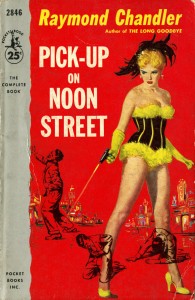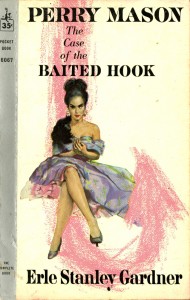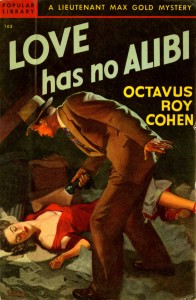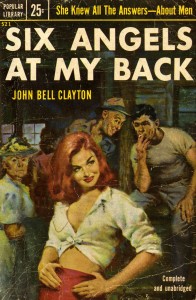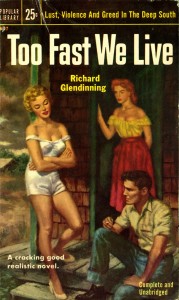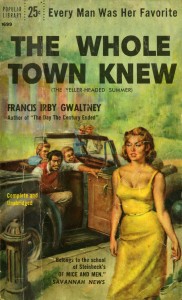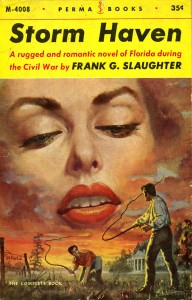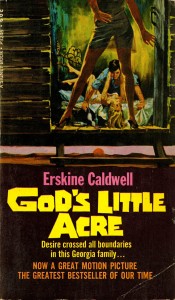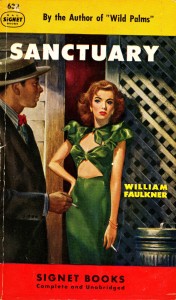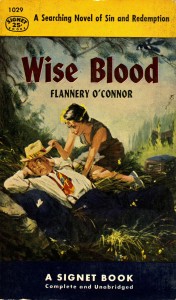Not a lot of rare book collections boast as many paperbacks as we have. That’s mostly for good reasons — they’re not collectible editions, and they’re much more fragile than hardback volumes. But those collections don’t know what they’re missing. Paperback books can also tell the story of the culture that produced them, and it’s often a different story than their more built-to-last brethren.
Today, we’re going to take a look at the sexed-up art that began to invade paperbacks in the 1930s. Taking their cues from the covers of pulp magazines — those cheap vehicles of sensational mystery, horror, and sci-fi stories — they used dramatic descriptions and attention-grabbing images, often of scantily clad women, to sell novels in a variety of genres. These examples range from 1947 to 1961, the height of the pulp epidemic.
Click on any image below to see a larger version.
Mystery and Detective Fiction
Since a lot of mystery and hard-boiled detective fiction writers wrote for pulp magazines, and some of their novels actually began their lives as short stories in those publications, dangerous women make a really reasonable choice for cover art.
Chandler, Raymond. Pick-up on Noon Street. New York: Pocket Books, 1952. [First published as collection, including the title story, “Smart-Alec Kill,” “Guns at Cyrano,” and “Nevada Gas.”] Call number: PS3505.H3224 P5 1952.
Gardner, Erle Stanley. The Case of the Baited Hook. New York: Pocket Books, 1947. [First published 1940.] Call number: PS3513.A6322 C19 1947.
Cain, James M. Shameless. New York: Avon, 1951. [First published 1951, as The Root of His Evil.] Call number: PS3505.A3113 S4 1951x.
Thrillers
Stories of crime and suspense also made a natural partnership with pulp art.
Cohen, Octavus Roy. Love Has No Alibi. New York: Popular Library, 1948. [First published 1946.] Call number: PS3505.O2455 L6 1945b.
Deal, Borden. Killer in the House. New York: New American Library, 1957. Call number: PS3554.E13 K4.
Clayton, John Bell. Six Angels at My Back. New York: Popular Library, 1953. [First published 1952.] Call number: PS3553.L386 S59 1953.
Bad Girls
It’s not entirely clear what genre these books are, which apparently isn’t the point. The point is, they’re scandalous!
Glendinning, Richard. Too Fast We Live. New York, Popular Library 1954. Call number: PS3557.L445 T66 1954x.
Willingham, Calder. The Girl in the Dogwood Cabin. New York: New American Library, 1961. [First published 1955, as To Eat a Peach.] Call number: PS3573.I4565 G5 1956x.
Gwaltney, Francis Irby. The Whole Town Knew. New York: Popular Library, 1956. [First published 1954, as The Yeller-Headed Summer.] Call number: PS3557.W3 W4 1955x.
The Scandalous South
The South proved a very fertile ground for stories of passion and scandal.
Slaughter, Frank G. Storm Haven. New York: Permabooks, 1955. [First published 1953.] Call number: PS3537.L38 S7 1955x.
Basso, Hamilton. Sun in Capricorn. New York: Popular Library, 1961. [First published 1942.] Call number: PS3503.A8423 S96 1942x.
Caldwell, Erskine. God’s Little Acre. New York: New American Library, 1961. [First published 1933.] Call number: PS3505.A322 G6 1961x.
Southern Literature in Disguise
Literary fiction was not immune. Comparatively speaking, these covers are tame, but they still exaggerate the tone of these novels. The only one that deals with sex, Sanctuary, is less salacious than simply disturbing.
Warren, Robert Penn. At Heaven’s Gate. New York: New American Library, 1949. [First published 1943.] Call number: PS3545.A748 A8 1949bx.
Faulkner, William. Sanctuary. New York: New American Library, 1951. [First published 1931.] Call number: PS3511.A86 S3 1931bx. [synopsis]
O’Connor, Flannery. Wise Blood. New York: New American Library, 1953. [First published 1952.] Call number: PS3565.C57 W5 1953x.
Find Out More
All the books seen above can be found at Hoole Library (in Scout, limit by Location), specifically within the Wade Hall Collection. Dr. Hall’s interest in the South, coupled with his tendency to collect on the basis of popular culture as much as academic value, make his collection a treasure trove of paperbacks of all sorts and their often curious art. Most of the examples above come from the New American Library or Popular Library (in Scout, limit by Publisher).
If you’d like to know more about any of these authors, they have profiles in the Dictionary of Literary Biography, a database available to UA students, faculty, and staff via the Libraries website.

